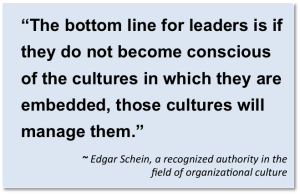 Many in the business community agree that a leader’s success (or even survival) in a role depends on their ability to work within the operational culture. And for those transitioning into new roles, culture lies at the root of many onboarding paradoxes. New Leaders are often hired to make changes, fix broken things, “take us to the next level,” and have early impact. Yet they must act within the context of the organizational culture to accomplish those imperatives. In addition, the New Leader must navigate not only the maze of corporate norms, but also the subculture in their own operation.
Many in the business community agree that a leader’s success (or even survival) in a role depends on their ability to work within the operational culture. And for those transitioning into new roles, culture lies at the root of many onboarding paradoxes. New Leaders are often hired to make changes, fix broken things, “take us to the next level,” and have early impact. Yet they must act within the context of the organizational culture to accomplish those imperatives. In addition, the New Leader must navigate not only the maze of corporate norms, but also the subculture in their own operation.
Seek First to Understand ...
While actively learning about their operations, New Leaders are likely to notice that the number of definitions of the culture roughly equals the number of people in the organization. Some ways people commonly describe their organizational culture include:
- “The way we do things around here.”
- “Lessons learned that are important to pass on to the next generation of employees.”
- “What we do when noone is looking.”
Without a common understanding, the New Leader may encounter barriers to gaining knowledge about the culture. This part of the onboarding process comes with a number of challenging questions:
- How is the culture described by the organization?
- Is it the same for top leaders as it is for others deeper in the organization?
- In the selection process, did the New Leader hear the “whole truth" about the culture, or just a depiction of how the organization hopes to function someday?
- What about discrepancies between how the inhabitants broadly describe the culture versus how the subcultures really function?
Addressing these questions can help the New Leader learn about, and demonstrate respect for, the existing culture (which has added importance for those hired as change agents).
Navigating the Culture – It's OK to Ask for Directions
To navigate the corporate culture, New Leaders must figure out not only “the way we do things around here,” but also “the way we don’t do things around here.” While they were hired to lead their operations, the organization will directly and indirectly signal to the New Leader what they can and shouldn’t do to drive success. Those who take the time to observe, ask questions about the best ways to operate, and then follow that advice, are ultimately more successful.
New Leaders also have diagnostic tools available to give them an early view into the performance climate of their own operations – the culture that will make or break their results.
Culture Informs Planning and Action
In order to adequately grasp the culture, New Leaders must take a step back during their first months on the job, and focus on learning rather than attempting to drive near-term performance. Some mistakenly assume that “because people downstream report to me, they will follow my direction and short-cycle their own.” These Leaders then move forward in a manner that runs counter to their operation’s culture and performance climate. Their outcomes can range from a simple lack of communication, to heightened frustration, and complete failure.
New Leaders can truly “get” the culture if they work with their Hiring Managers to construct deliverables that:
- Facilitate learning about the corporate and operational culture.
- Demonstrate that they have incorporated that knowledge.
- Start moving the New Leader’s operation toward desired goals and performance levels.
Working with (and within) the organizational culture that existed before New Leaders came on board will help smooth their transitions, balance the paradoxical nature of onboarding, and deliver results.
The Myth of "Fit"

Make sure your executive hires have everything they need to be successful.
-
Our Blog
- To Lead or Not to Lead? A Skilled Project Manager Weighs In
- Why Do We Perpetuate the Myth of New Leader “Fit”?
- Until Success Do We Part: How to Decide If a Project Management Role is For You
- Starting the Journey: A New Project Manager’s Guide to Implementation
- The Myth of the Flawless Outsider
- Culture Makes or Breaks New Leaders
- New to Your Job? Don’t Let Your Rival(s) Drag You Under
- The OnBoarding Paradox: How New Leaders Prevail
- New Leader Failure: A Problem or A Symptom?
- What Surprises Await? The 4 Dilemmas that Can Derail Newly Promoted Leaders
- Why New Leaders “Don’t Get It” And What To Do About It
- The Credibility Trap
- Don’t Forget to Add Relationships to Your “To Do” List
- OnBoarding as Risk Management
- Managing Change: How to Include the Team and Gain Support
- The #1 “Killer” of New Leaders: Failure to Achieve and Maintain Role Clarity
- New Leaders: How Does Your MBTI Profile Influence Your Transition?
- E vs. I: How Does Your MBTI Preference Influence Your Transition?
- S vs. N: How Does Your MBTI Preference Influence Your Transition?
- T vs. F: How Does Your MBTI Profile Influence Your Transition?
- J vs. P: How Does Your MBTI Profile Influence Your Transition?
- Identifying Your Rival(s): It’s Not Who You Think It is …
- Rivals Part 2: Bringing Them into The Fold
- Your New Team: Sizing Up, Investing In, or Trading Out
- The Importance of Feedback – Early and Ongoing
- Don’t Underestimate the Importance of the Personal Transition
- OnBoarding and the Importance of Early Impressions – Part 1
- Early Impressions — Part 2: Containing and Repairing Missteps

